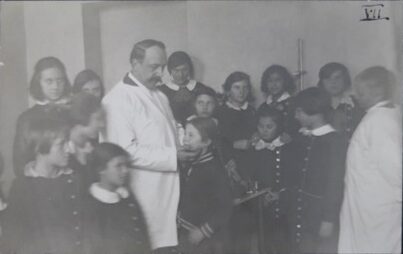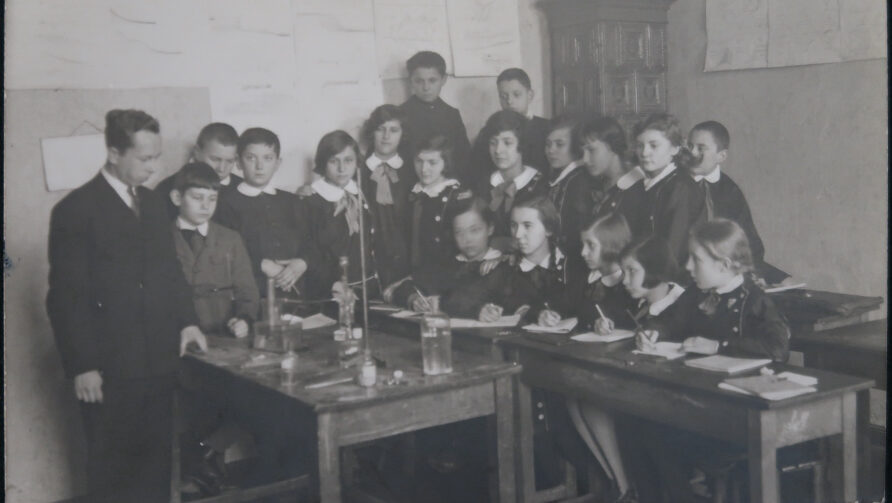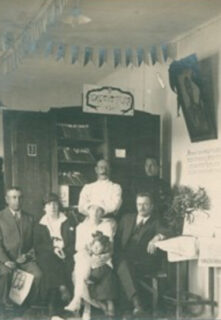In 1924, a private gymnasium opened its gates, welcoming children of Russian exiles to the Bulgarian capital of Sofia. The founder of the school, Varvara Pavlova Kuzmina, a teacher from St. Petersburg, had settled in the Balkan state after becoming a refugee following the Bolshevik Revolution and the ensuing civil war. Named V. P. Kuzmina after its founder, the gymnasium belonged to a large network of Russian educational institutions that emerged internationally during the 1920s. In the interwar period, Russian schools abroad, including orphanages and kindergartens, evolved into key sites of knowledge production about the Russian homeland, its culture, and history. After years of missed schooling, prolonged violence, and the loss of home, educators and parents expressed concerns about the children’s ability to speak, read, and understand Russian, as well as their intellectual development.1
Despite their social value, most of these Russian schools operated for no more than a decade, even though most exiles remained abroad for much longer. Their singular national and anti-communist agenda almost exclusively targeted members of the Russian-speaking youth and promoted an isolationist strategy that intended to prevent children from assimilating into the host country. Unlike these schools, which directed their energies towards their own population, V. P. Kuzmina adopted an alternative strategy, one embedded in the reality of integration and cultural exchange between these Russian refugees and their host country, Bulgaria. Within a few years of its opening, the gymnasium achieved broad recognition and gradually developed into an elite school that taught Russian and Bulgarian children together. Thus, an institution that aimed to produce knowledge primarily by and for refugees evolved into a shared space of learning, embraced by both newcomers and locals as their own.
From Russia’s Imperial Capital to Bulgaria’s Refugee Settlements
The school’s origins date back to 1906, when Kuzmina opened an elite school in pre-revolutionary St. Petersburg to immerse children in the study of Western European languages. After years of successful operation, the school was forced to close because of the revolution; dozens of students dropped out and, like thousands of other Russians, began to flee the city. Kuzmina and the teaching staff followed, making the ultimate decision to leave their homes and settle in Bulgaria, at least temporarily. For the first few years, most exiles expected their sojourn abroad to only be temporary as they anticipated an imminent collapse of the Bolshevik regime and a swift return home. However, educating children properly to ensure they preserved their Russian identity and culture presented a critical task for as long as they remained abroad.

The small yet burgeoning capital city of Sofia provided Russian refugees with opportunities for creative expression in a hospitable and familiar environment. Occupying a small one-story building with three rooms at the center of the capital, the V. P. Kuzmina Gymnasium first opened as a preschool in the spring of 1923. A year later, it began to accept secondary school students and formally branded itself as a Russian gymnasium. Until June 1923, the radical Agrarian Union government of Aleksandar Stamboliyski expressed an ambivalent attitude toward the exiles, mainly due to their anti-communist and pro-monarchist affiliations. However, the coup that deposed Stamboliyski and brought the conservative government of Aleksandar Tsankov to power signaled the beginning of a favorable policy towards Russians in Bulgaria. The close cultural relationship between Bulgaria and Russia contributed to this condition. Four decades earlier, the Russian Imperial Army had marched through Bulgaria, liberating the nation from the control of the Ottoman Empire. Across the country, statues and city streets named after Russian leaders and military heroes commemorated this historical bond, expressing pro-Russian and Slavophile sentiments. Protests against the Russian exiles occasionally broke out from a part of the Bulgarian population sympathetic to the Soviet Union. Yet, many members of Bulgaria’s political and intellectual elite, who had previously traveled in Russia, spoke the language, and had even studied in the former Russian Empire, expressed their support of Russian refugees and their cultural institutions.
By the time Kuzmina, with the help of three of her former colleagues, was establishing the school in 1924, this positive climate facilitated the process. The prime minister’s pledge to “preserv[e] the Russian national character and produce real Russians” gave the green light to Russian educational centers and their growing public presence in Bulgarian society.2 At its launch, the school had nine students enrolled, but within a couple of years this figure had more than tripled, with over forty students by 1925 and 240 by 1933.3 The intellectual quality of the teaching staff contributed decisively to this success, generating a flow of public interest for the school’s pedagogical mission. Kuzmina’s network from her time in St. Petersburg proved essential for recruiting outstanding instructors, who, like her, had fled Russia and settled in Bulgaria as refugees. Professors and specialists in a wide range of fields, from literature and philosophy to geography and chemistry, marshaled their expertise and designed a modern curriculum comparable to those of private colleges in Europe. Russian subjects aimed to cultivate the “love for the motherland,” whereas the “thorough knowledge of two modern languages,”4 to be selected from French, English, or German, had formed a key component of elite education since the Russian Empire and proved indispensable for living abroad.
Attitudes of exiles toward Russian education began to shift when they realized that returning home was increasingly unlikely. Stalin’s consolidation of power at home highlighted the durability of the Soviet Union. After almost a decade, a generation of children had been born and raised abroad with no plans to return in the foreseeable future. Responding to these conditions, students and parents chose assimilation over pursuing Russian diplomas, which had grown to seem impractical. But most Russian schools struggled to adapt quickly. Declining enrollments and reduced finances prompted a series of closures, leaving an educational vacuum for families that wished to continue receiving Russian lessons.

The V. P. Kuzmina Gymnasium, on the other hand, capitalized on the its growing prestige among Bulgarians and reframed its mission, transforming it from a simple school for exiles into an institution with an academic program designed to appeal to both Russians and Bulgarians. According to brochures and reports about the school, it aimed to raise children in an “Orthodox and moral way,” to teach “modern languages,” and “to make a valuable contribution to this Balkan Slavic land.”5 By the late 1920s, the school’s emphasis on languages, especially French, began to attract more interest among Bulgarians, who attributed a certain prestige to this type of Russian education. After 1926, the Ministry of Education granted the gymnasium the right to issue two types of certificates: a Russian one, following criteria determined by the Bureau of Russian Schools Abroad based in Prague; and a Bulgarian one, for which a representative of the Bulgarian Ministry of National Education was required to supervise final exams that took place in the school. These developments gradually boosted enrollments of Bulgarian children. The distribution of the nationalities of its students reflects this shift. During the academic year of 1930–31, out of a total of 160 students, 90 were counted as Russian, 66 Bulgarian, and 4 foreign.6 By the next academic year, administrators counted 183 students, 86 of whom were Russian, 93 Bulgarian, and 4 foreign. Most of the Bulgarian students paid annual tuition whereas more than half of the Russians received a scholarship combined with room and board.
The gymnasium’s reputation as an institution promoting French language and culture also attracted the attention of the French diplomatic mission and the Alliance française, which approached Kuzmina with the intention of partnering with her. The mélange of languages and subjects taught at the school generated a special identity for its students. For instance, on national Bulgarian holidays, such as the Day of Cyril and Methodius, Russian and Bulgarian students of the V. P. Kuzmina Gymnasium would parade through the center of the city, wearing “elegant berets” together with the traditional uniforms.7 And on one occasion, a representative of the French government attended the operetta Cinderella at Sofia’s Royal Theater, in which students of the gymnasium performed in French.
An Unexpected Closure
The Kuzmina Gymnasium’s academic reputation did not shield the school from the economic crisis of the 1930s. For a few years, it had been among the recipients of a state-sponsored program, Russian Action, which aimed to subsidize the studies of poor Russian students. However, by the late 1930s, the Bulgarian government reduced its funding for the school. At the same time, the school administrators were accused of “inefficiency” and of operating the school on an “un-business-like model” that functioned more as “a charity than an enterprise.” Accordingly, the school hired a new administrator to impose a set of financial reforms.8 The new director, who had previously run an American school for Russian refugees, found it unsustainable in the long run that almost half of the student population received a scholarship. Fearing for the school’s survival, some of Bulgaria’s authoritative scholars attested to its value, urging the government and humanitarian organizations—including the League of Nations—to continue supporting the institution.

When Bulgaria chose to side with the Axis Powers in World War II, the government characterized almost all of the languages the school taught, apart from German, as “enemy languages,” forcing the school to close. Kuzmina and the school’s instructors hoped that operations could be restored after the end of the war; however, the arrival of the Soviet Army in September 1944 signaled a series of dramatic changes for all Russians in Bulgaria. Foreign and private schools were no longer allowed to operate legally. This decision stirred vehement reactions in Sofia. In her writing, T. K. Pchelnicheva, a descendant of Russian refugees in Bulgaria, described how Bulgarian parents protested the government’s decision, arguing that the gymnasium was not foreign but a local school where Russians and Bulgarians learned together. Besides, they had claimed, “the majority of the Russian children had become, by that point, Bulgarian citizens.”9 Yet, the government did not alter its policy—the V. P. Kuzmina Gymnasium, after educating hundreds of students over twenty years, did not reopen. Kuzmina’s connections with the French embassy granted her a visa, and she subsequently remigrated to Paris. Russian students, who after 1946 were given the right to assume Soviet citizenship, attended a Soviet school, exclusively in Russian, while Bulgarian students resorted to Bulgarian ones.
Conclusion
Mixing children of the two nationalities represented not only a successful pedagogical achievement, but it also ensured the school’s survival for almost two decades. The social and intellectual capital Russians carried with them—teaching instructors with prestigious degrees, former professors, and other scholars who found refuge at the school—built an institution whose intellectual value expanded beyond the narrow borders of the Russian community. Turning outward toward the wider world in emphasizing languages as valuable skills, the school also saw its mission in uniting the two national groups under a set of shared Slavic values, including universal education. Ultimately, both Russians and Bulgarians embraced the institution as their own, highlighting how a shared educational space generated multiple attachments.

Charis Marantzidou is a PhD candidate in Modern European History at Columbia University. She specializes in Twentieth-Century Russian and Eastern European History. She is writing a dissertation about the history of the Russian emigration in Bulgaria from the October Revolution to the 1950s.
- For an analysis of Russian education in exile, see Irina Mchitarjan, “Prague as the Centre of Russian Education Emigration: Czechoslovakia’s Education Policy for Russian Emigrants (1918–1938),” Paedagogica Historica 45, no. 3 (June 2009): 369–402. ↩︎
- V.A. Shevchenko, “K.I. Ivanov i reorganizatsiia ruskogo uchebnogo dela v Bolgarii v 1920-30e gody,” Istoriia i Arkheologiia 12 (2017): 326–37, 327. ↩︎
- Alexander Ratiev, TsDA, f.1577k, op. 1, a.e.9, l. 185. ↩︎
- “Shkola V.P. Kuzmina,” Baronessa Mariia Dmitrievna Vrangel’, Box 22, Folder 17, Hoover Institution Library & Archives (HILA). ↩︎
- TsDA, f. 1577k, op.3, a.e.104, l.7. ↩︎
- “Russian Schools, Bulgaria,” HILA. ↩︎
- Alexander Ratiev, TsDA, f. 1577k, op. 1, a.e.9, l. 186. ↩︎
- Boris Ermolov to Seth Gano, October 6, 1932, Box 6, Folder 22, CERYE, Bakhmeteff Archives of Russian & East European Culture (BAR). ↩︎
- T. K. Pchelnicheva “Russkaia Smeshannaia Gimnasiia V.P Kuzminoi v. g. Sofia (Lichei V.P. Kuzminoi),” http://sribru.com/html/upload/files/Microsoft%20Word%20-%20Licei%20Kuzminoi-new%281%29.pdf, accessed September 15, 2023, p. 24. ↩︎
